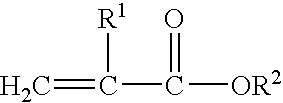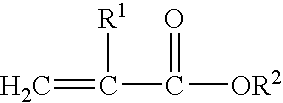Wet surface adhesives
a pressure-sensitive adhesive and wet-surface technology, applied in the field of pressure-sensitive adhesives, can solve the problems of reducing the tack of hydrophilic acidic comonomer-containing acrylate copolymers, affecting the tack of acrylate copolymers, and general unsuitability for wet-stick adhesives, etc., to achieve the effect of reducing the amount of energy, preventing premature vitrification of copolymers, and overcoming
- Summary
- Abstract
- Description
- Claims
- Application Information
AI Technical Summary
Benefits of technology
Problems solved by technology
Method used
Image
Examples
examples
Test Methods
Peel Adhesion
Peel adhesion is the force required to remove an adhesive-coated, flexible sheet, material from a test panel. Peel adhesion is measured at a specific angle and rate of removal. Peel adhesions in the range of 3 N / dm or higher, as measured by the following procedure are generally considered acceptable as wet stick adhesives according to the present invention. In the following examples, this peel adhesion force is expressed in Newtons / decimeter width (N / dm) of the coated sheet.
The procedure followed was:
A strip (1.27 centimeter wide) of the adhesive-coated sheet was applied to the horizontal surface of a clean test plate with at least 5 lineal centimeters of both surfaces being in firm contact. One pass with a 2-kilogram hard rubber roller was used to laminate the strip to the plate. The free end of the coated strip was doubled back nearly touching itself so the angle of removal was 180°. The free end was attached to the adhesion tester scale. The glass test pl...
examples 1-13
Preparation of Packaged Polymerized Acrylate Wet-Stick Adhesive Compositions
Packaged polymerized acrylate wet stick adhesive composition were packaged, polymerized, coated and tested according to the following method: Two sheets of a heat sealable ethylene vinyl acetate film having a thickness of 64 micrometers and a 6 mole % vinyl acetate content (VA24, commercially available from Consolidated Thermoplastics Co.; Schaumburg, Ill.) were heat sealed on the lateral edges and the bottom to form a rectangular pouch measuring approximately 5 cm wide. The polymerizable mixtures comprising the (meth)acrylate monomers, hydrophilic acidic comonomers, plasticizing agent, initiators and chain transfer agents described in Table 1 were prepared and 20 ml of each mixture was delivered via syringe into the unsealed edge of the pouch. The unsealed edge of the filled pouch was then heat sealed to form 5 cm by 8.9 cm pouches containing 19 grams of the polymerizable mixture.
The pouches were placed in ...
example 14-16
were packaged and polymerized the using the same methods as Examples 1-13, except that no IRGANOX 1076 antioxidant was added and the photoinitiator was changed to IRGACURE 651. Comparative Example C1 is a conventional acrylic pressure-sensitive adhesive formulation and serves as a reference composition. These compositions are described in Table 4.
TABLE 4AcrylicPlasticizingIRGAcrylateAcidAgentIOTG651Ex.(parts)(parts)(parts)(parts)(parts)14IOA (50)50PYCAL 94 (43)0.070.1515IOA (50)50MPEG 550 (43)0.070.1516IOA (50)50PPG 1000 (43)0.070.15C1IOA (90)10None0.070.15
The packaged polymerized adhesives were melt processed, coated at a thickness of 50 micrometers onto a siliconized release liner, and the coating transferred onto a 25 micrometer thick biaxially oriented polypropylene backing to form tape samples for “dry” and “wet” peel adhesion testing against a variety of non-biological test plates. “Wet” testing was done by flooding the test plate surface with water and then laying the tape sa...
PUM
| Property | Measurement | Unit |
|---|---|---|
| Tg | aaaaa | aaaaa |
| Tg | aaaaa | aaaaa |
| melting point | aaaaa | aaaaa |
Abstract
Description
Claims
Application Information
 Login to View More
Login to View More - R&D
- Intellectual Property
- Life Sciences
- Materials
- Tech Scout
- Unparalleled Data Quality
- Higher Quality Content
- 60% Fewer Hallucinations
Browse by: Latest US Patents, China's latest patents, Technical Efficacy Thesaurus, Application Domain, Technology Topic, Popular Technical Reports.
© 2025 PatSnap. All rights reserved.Legal|Privacy policy|Modern Slavery Act Transparency Statement|Sitemap|About US| Contact US: help@patsnap.com



